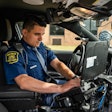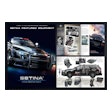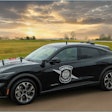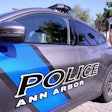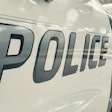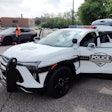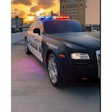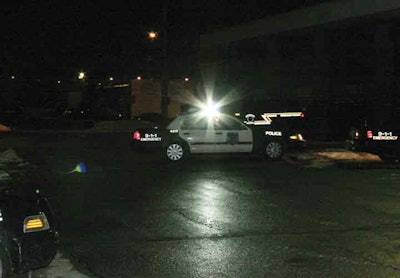 Photo courtesy of Tom Wetzel.
Photo courtesy of Tom Wetzel.
It's been my experience that the alley lights on police cruisers are among the most underutilized tools in law enforcement. That's a shame because proper use of alley lights can make you safer, make you a more effective crime fighter, and enhance your relationship with the public you serve.
Your alley lights can assist you in nighttime conditions by providing light to the sides of your car. They can help you locate addresses and expose areas hidden in darkness.
And they are so easy to use. By moving a toggle switch or pressing a button on your cruiser's emergency control panel, you can turn them on and off as needed.
On the Periphery
When searching for a suspect or trying to discover criminal activity during the night, you can light up areas on both your right and left with your alley lights. This lets you see things or people that you may have had trouble spotting without the aid of these tools.
You may also want to run your alley lights for periods of time during regular patrol when the discovery of suspects is not necessarily imminent and you're not responding to a call about a crime in progress. Doing so may help you uncover unexpected activities and people.
During nighttime patrols of residential neighborhoods, business districts, park settings, or farm lands, you may find yourselves focused on what you can see in front of your vehicle. This tunnel vision is promoted by your headlights, and it's a good thing since you should concentrate on where you are going. But you are not just driving around in the dark, you are patrolling.
Your head should be on a swivel as you scan the environment for threats and criminal activity. And your cruiser’s headlights just won't help you see all that's going on in the environment around you. Headlights are really limited in how much they can pick up from the sides, which is why you need alley lights.
Shaking the Bushes
By turning on and leaving on both of your cruiser's alley lights for a limited time while patrolling you can make better use of your peripheral vision and catch things out of the corner of your eyes. The "things" you see that you wouldn't have seen without the alley lights could be a broken window, or a suspicious-looking man standing next to a tree, or a person sitting low in a car parked in a driveway.
What could have been completely overlooked can be very clear when a good light is shone upon it. I work in an area where winters includes lots of snow, and I have noticed that by using my cruiser's alley lights I can observe footprints in the snow near a home where I may have missed them if only relying on available ambient light such as moonlight.
Your cruiser's alley lights in conjunction with its rotating spotlight can light up large areas at a time such as in a partially wooded park where ambient lighting is very low and there are various objects that can provide partial cover for a suspect. Regular use of alley lights is also valuable for patrolling business districts after hours when you are keeping an eye out for pried doors that may be slightly open or damaged windows indicative of breaking and entering.
You have probably been told by your bosses to go and "shake the bushes" while out on patrol to see what you can find. When you drive by an area and light it up with your alley lights, you are shaking those bushes.
If people are up to something criminal, they don't want to be lit up by your car. Also being lit up may cause them to think that you are on to them, resulting in sudden flight, which will alert you to their presence. Proper use of your alley lights can take away the bad guys' cover of darkness and diminish their opportunities for escape.
Tactical Advantages
Using alley lights can also provide a tactical advantage. When people approach your cruiser from the side, they will be illuminated to allow better observation of what is in their hands as well as available descriptors such as clothing and hair color. Also, the light can impair a person's vision, which can affect aim, in case the person was intending to direct fire at you.
A useful way to appreciate what alley lights can do is to stand outside your cruiser when the alley lights are on and look at them. Although not as bright as the rotating spotlight, they can still provide a distraction for someone looking directly into them. Sometimes that is all that’s needed to cause a suspect to become slightly disoriented, if even momentarily, and have trouble acquiring a good sight picture against you.
Community Policing Value
Alley lights are not just a search tool and a tactical distraction; they are also a way of letting the community know that you are on the job. From a community policing perspective, regular and targeted use of alley lights can really have a long-term impact.
When you are patrolling residential neighborhoods during night conditions, leave your alley lights on for a bit. The lights let those you serve know you are out and about keeping their neighborhoods safe. I believe most law-abiding people appreciate seeing a police cruiser patrolling their street. It helps create a feeling of security and also lets them see a return on their tax investment.
A targeted application of high-visibility lighting can have an impact. When people are sitting at their dinner tables or relaxing, they may occasionally look out their windows and notice a light flash from your cruiser's alley lights. This tells them an officer is patrolling their neighborhood. The quick lighting effect is hardly intrusive and may increase the peace of mind for those who appreciate a periodic patrol on their street.
As people are generally not used to seeing patrols conducted with additional lighting, a break-in/buy-in period will likely take place as they get used to the idea and are not alarmed by it. If this is to become a practice of your agency, the agency brass may want to try to inform local residents and the business about your increased use of alley lights.
Another community policing benefit from the use of alley lights is obvious, crime prevention. Bad guys will note your patrols and possibly be deterred from taking criminal action by your presence.
When officers light up areas where criminal activity such as drug sales and prostitution are common, it may discourage further congregating of people with criminal intent. People who behave badly don't like the glare of a light to expose them and their actions.
A Targeted Approach
It is important here to emphasize that these applications of additional lighting while patrolling should be targeted and limited. You do not want to drive around for hours with your alley lights on.
There will certainly be times when extra lighting is not appropriate. There will even be times when you will want to drive without any lights on. And rightfully so.
Just as there are times when extra lighting can benefit you tactically, there will be other times that it could work to your disadvantage. It’s your call. And the decision must be based on the type of area you are patrolling and your objective.
In any discussion of the use of alley lights, officers often express concern that having the alley lights on could give up their position when traveling at night, as suspects would see them from a distance and know that a police cruiser is approaching. You have to apply common sense and balance to the use of alley lights.
Tom Wetzel is a northeast Ohio suburban police lieutenant, SWAT officer, trainer, and certified law enforcement executive.









